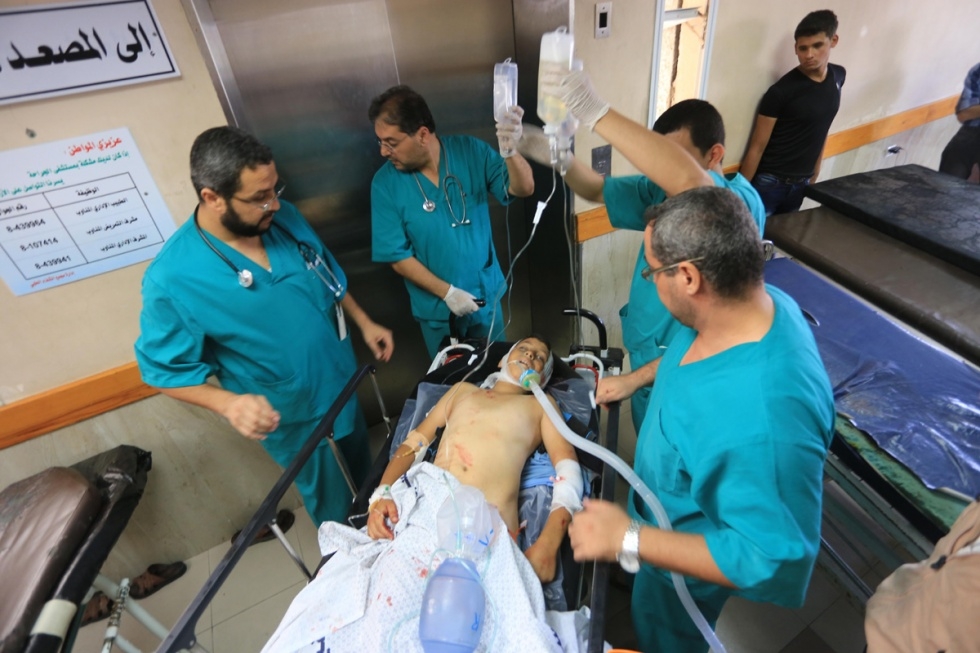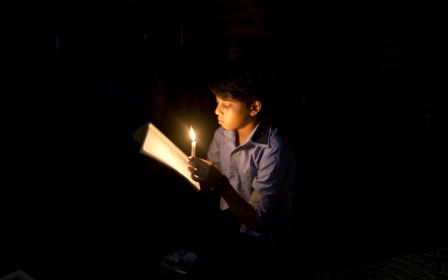Gaza's Shejaiya carnage at Shifa morgue

“No, it’s not him” says the brother of Mohammed Al Mobayed, as he moves on to the next body searching for his brother. Half of the family is at reception, and the other half at the morgue.
The ambulance arrives, asking crowds to clear the road so as to pass through and offload the casualties and dead. As ambulance doors open, people run forward looking for their missing relatives.
“No, that’s not him, dad” one of the brothers screams to his older father as the ambulance arrives.
A shout comes over the air to all Al Mobayed family, “Here is Mohammed”. The whole family runs to him, thinking he is alive.
But Mohammed’s body arrives with scores of other bodies and mixed bags of fingers, heads, chests, legs and feet.
It’s up to ambulance crews to sort through the body parts to match them correctly for identification before preparation for shroud and burial.
The screams of grief begin among all members of the family—but everyone else is still looking for their own missing loved-ones-hundreds of people are here-and all are looking for different relatives and friends—all are worried that the next ambulances will bring their relatives to the hospital doors.
The human carnage of Shejaiya began this morning when Israeli tank shells started a massive shelling barrage on people’s homes. The heavy tank shells hit houses directly; some of the people able to run away under gunfire, but so many others were hit.
Umm Ahed Al Qanou, 55 years old had to walk 5 kilometers with her 8 children, until she could find transport to take her and the children somewhere safe—here at Shifa hospital, she does not know where her husband is.
She is caught between two fires: her 8 hungry children by her side, and a husband and ninth child she does not know the whereabouts of. One young man helps her look for husband or his body, as may be.
She still hopes he and her other child are alive—but no one knows yet, for sure.
Ambulance crews say they were unable to evacuate bodies, laid out, or throw on the street, by bombs. “It’s a massacre. Dead and injured men, women, children are on the streets, and we are unable to evacuate them because we are being shot at too”, screams the ambulance driver to MEE.
Four Israeli soldiers died last night apparently in a fierce battle with Palestinian armed-resistance involving anti-tank shells and automatic-weapons. At least 100 Palestinians were killed on Sunday and over 300 injured, say doctors at Shifa hospital. The numbers are increasing, as more bodies are dug out from under piles of bombed rubble that used to be homes. The death toll since the start of Israel’s attacks stands at 425 people killed, and 2,900 injured, the majority being civilians, says United Nations.
Red Cross attempted to organize a ceasefire to evacuate bodies, but medics say it’s too short a time, to dig deep for bodies that are not visible on the streets.
This has been the fiercest night since Israel’s war began two weeks ago. Most families were bombed while sleeping, others killed while fleeing their homes in search of shelter, says Osama Al Orbaji, 28 year old.
“We were in our homes, when we heard exchange of fire at 02:30 this morning. I thought it would end soon”.
Just before the sun sets on Shejaiya-east of Gaza City, tank shells started to hit everywhere. On average 14 tank shells were fired in 45 seconds, counts MEE.
“Each time my family and I attempt to get outside, we are faced with tank shells coming toward us, there is no where to escape to”, Al Orbaji says, as he stands searching for bodies or other human body parts identified as cousins.
“I saw the massacre of the Ayyad family, when tank shells hit them over and over again, 12 people were trying to flee, but were blown to pieces, splattered over the walls and concrete”, Osama says, while he also keeps looking at the ambulances still arriving and crowds of people screaming in fear.
“The mother of Ayyad was holding her children by their hands. But I saw them disappear when the Israeli tank shell hit”, he says.
Then a small child’s face- the top of a child’s head—the rest was split into pieces. His mother’s body blown into small pieces, he says as he weeps.
“I started to run with my family. Under our feet were the bodies of our neighbors, and blood everywhere” he says, as he shows MEE the blood on his bare feet, over his trousers and what appears to be the flesh of someone else still on sticking to his forehead.
“They bombed mosques, schools, homes, cars and everything—the area is turned into just the ruins and rubble of bombed homes and bodies everywhere”, he adds.
“My relatives are still indoors, my in-laws are stuck there and we still don’t know if they are alive”, he adds.
His only option is to wait for the ambulances to come—if no ambulance comes, Osama gets more scared that bodies are still underneath buildings and no-one has been able to evacuate them.
“The baby son of my in-laws is 2 months old. I know he was killed early morning in his house next to Al Motasem mosque” he says.
Yet, the tiny body he is looking for is not yet among the burnt, cold bodies of those already in the morgue.
New MEE newsletter: Jerusalem Dispatch
Sign up to get the latest insights and analysis on Israel-Palestine, alongside Turkey Unpacked and other MEE newsletters
Middle East Eye delivers independent and unrivalled coverage and analysis of the Middle East, North Africa and beyond. To learn more about republishing this content and the associated fees, please fill out this form. More about MEE can be found here.




